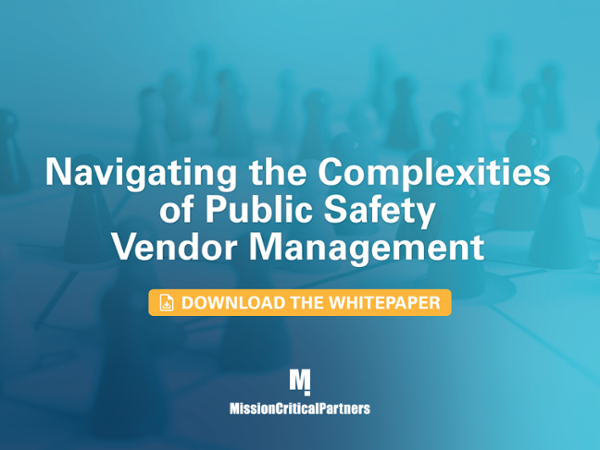The Three Components of an Effective Vendor Support Agreement
Posted on April 18, 2019 by Mark Perkins
When it comes to public safety vendor management, times have changed—dramatically.
A decade and a half ago, information technology (IT) managers and agency leadership dealt principally with a small number of support vendors. Service agreements were simple and easy to understand. Today, in stark contrast, the landscape is much different. The average agency has nearly 30 agreements—covering a plethora of systems—on which to stay current. The vendor support agreements themselves have become dramatically more complex. And many of the personalized relationships that were formed in the past no longer exist. What’s more common today is that customer support is provided by network operations centers or help desks where service and troubleshooting might be addressed by a different technician every time a new ticket is opened.So, what does it take to be more effective at navigating the complexity of vendor support and management in today’s public safety communications environment? How can you begin to trust your maintenance and service providers again?
It all starts with adjusting your approach in three key areas: building the agreement; managing vendor accountability; and negotiating your agency’s position. Here are some tips:
Building the Support Agreement
Examine one of your service agreements closely and it’s likely that it contains at least one vulnerability we commonly observe. A clearly defined agreement is key, as it serves as the roadmap that sets service and support delivery expectations.
A good place to start is with how the service your agency receives as part of the vendor agreement is described. How detailed is the service description? Does it contain overwhelming or confusing language? Do you see an opportunity to include more detail in the description without increasing its complexity?
Another important aspect is how your support packages are priced. All too often, agencies choose the lump sum pricing packages that commonly are offered by vendors. On the surface, they appear to be less complex than line-item pricing. However, that’s often not the case. Lump sum pricing often comes with ambiguity, making it far more difficult for agencies to hold the vendor accountable in the future.
Managing Public Safety Vendor Accountability
Building an effective agreement as discussed above is the key to being able to hold your vendors accountable, specifically when it comes to how they’re performing against clearly defined service level agreements (SLAs).
Ask yourself these questions: are tickets being responded to and resolved within the timeframe promised based on severity level? Do you feel as if your agency is often on its own, attempting to stitch together the information needed to address an IT issue?
We recommend using the Information Technology Infrastructure Library (ITIL) standards to guide how IT services are delivered at your agency. ITIL is a repository of documents that describe a framework of best practices for delivering IT services. The use of standards-based service management practices will help your agency manage risk and build a more stable, adaptable IT environment.
Negotiating Your Agency’s Future Position
This final phase is nearly impossible without knowing the answers to the questions above, and more.
Data-driven negotiations are key to putting agencies in a better position to craft stronger, more cost-effective agreements moving forward that fit their needs. Injecting relevant data into vendor negotiations brings significant insight to the discussion—this tactic is not intended to put the vendor on the defensive, but rather to add context and lead to a better long-term deal for both parties.
Another option is to bring in an outside provider to assist with the vendor negotiation process. Doing so will bring objective oversight to the process that helps agencies shave unnecessary costs from their annual agreements, strengthen service delivery and reduce risk.
Navigating the vendor management process can be challenging and unnerving as more technology enters the public safety environment, adding to the quantity of vendors with which agencies must deal and placing more strain on network environments. The considerations described above will help to build vendor agreements that deliver maximum value to public safety agencies and keep their systems, and the networks supporting them, running smoothly.
You can read more about these tips and learn more by downloading our whitepaper, “How to Navigate the Complexities of Vendor Management in Today’s Environment.”
Related Posts
How to Lessen the Impact of Public Safety Vendor Consolidations
Four Tips to Avoid a Failed Public Safety IT Project



